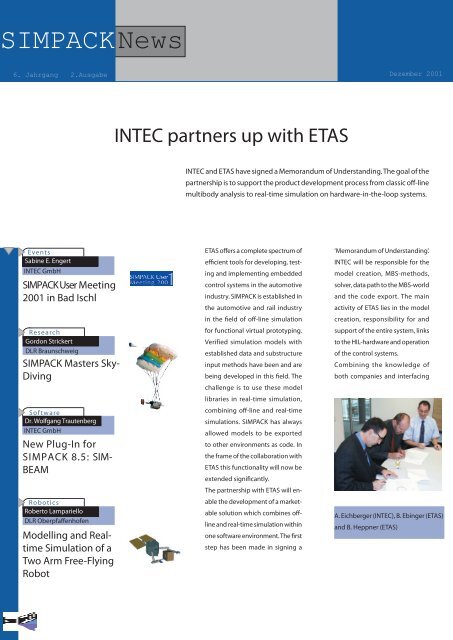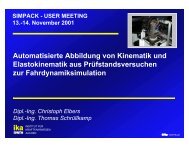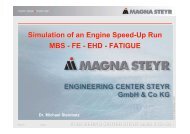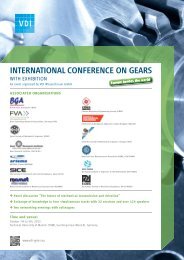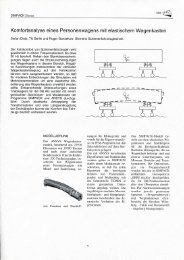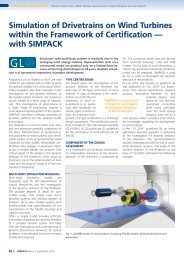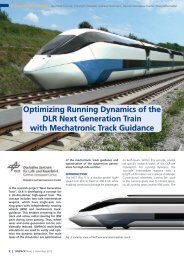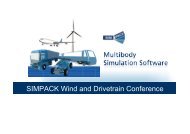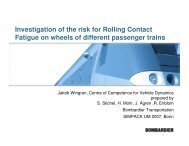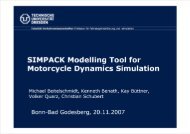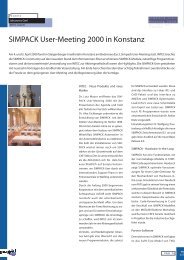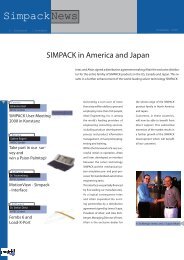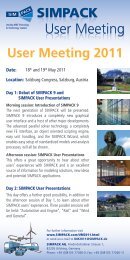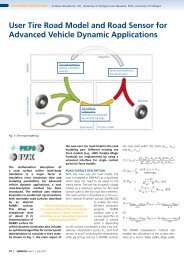SIMPACKNews
SIMPACKNews
SIMPACKNews
You also want an ePaper? Increase the reach of your titles
YUMPU automatically turns print PDFs into web optimized ePapers that Google loves.
<strong>SIMPACKNews</strong><br />
6. Jahrgang 2.Ausgabe<br />
Events<br />
Sabine E. Engert<br />
INTEC GmbH<br />
SIMPACK User Meeting<br />
2001 in Bad Ischl<br />
Research<br />
Gordon Strickert<br />
DLR Braunschweig<br />
SIMPACK Masters Sky-<br />
Diving<br />
Software<br />
Dr. Wolfgang Trautenberg<br />
INTEC GmbH<br />
New Plug-In for<br />
SIM PACK 8.5: SIM-<br />
BEAM<br />
Robotics<br />
Roberto Lampariello<br />
DLR Oberpfaffenhofen<br />
Modelling and Realtime<br />
Simulation of a<br />
Two Arm Free-Flying<br />
Robot<br />
INTEC partners up with ETAS<br />
INTEC and ETAS have signed a Memorandum of Understanding. The goal of the<br />
partnership is to support the product development process from classic off-line<br />
multibody analysis to real-time simulation on hardware-in-the-loop systems.<br />
ETAS offers a complete spec trum of<br />
efficient tools for de velo ping, test-<br />
ing and imple menting embedded<br />
control systems in the automotive<br />
industry. SIMPACK is estab lished in<br />
the automotive and rail industry<br />
in the field of off-line simulation<br />
for func tional virtual prototyping.<br />
Verified simulation models with<br />
estab lished data and substructure<br />
input methods have been and are<br />
being de veloped in this field. The<br />
challenge is to use these model<br />
libraries in real-time simu lation,<br />
com bining off-line and real-time<br />
simulations. SIMPACK has always<br />
allowed models to be exported<br />
to other environ ments as code. In<br />
the frame of the collaboration with<br />
ETAS this functionality will now be<br />
extended significantly.<br />
The partnership with ETAS will enable<br />
the development of a marketable<br />
solution which combines offline<br />
and real-time simulation within<br />
one software environ ment. The first<br />
step has been made in signing a<br />
Dezember 2001<br />
‘Me mo ran dum of Under standing’.<br />
INTEC will be responsible for the<br />
model creation, MBS-methods,<br />
sol ver, data path to the MBS-world<br />
and the code export. The main<br />
activity of ETAS lies in the model<br />
cre ation, res pon sibility for and<br />
support of the entire system, links<br />
to the HIL-hardware and operation<br />
of the control systems.<br />
Combining the knowledge of<br />
both companies and interfacing<br />
A. Eichberger (INTEC), B. Ebinger (ETAS)<br />
and B. Heppner (ETAS)
introducing hp’s<br />
workstation<br />
dreamteam<br />
the software an ideal partnership was<br />
found, which closes the gap bet ween<br />
the real-time and the off-line world.<br />
A continuous and open solution can<br />
now be offered from off-line simulation<br />
to the hard ware-in-the-loop test<br />
of em bed ded control units.<br />
ETAS GmbH was founded in 1994<br />
as a subsidiary of Robert Bosch<br />
GmbH and is having its Head<br />
Office in Stuttgart, Germany. The<br />
product range comprises a complete<br />
spectrum of efficient tools<br />
for de ve loping, testing and im plementing<br />
embedded control systems<br />
in the automotive industry.<br />
ETAS currently has 500 employees<br />
world-wide and attained a revenue<br />
of EUR 83 million in 2000.<br />
With its own subsidiaries in Ann<br />
Arbor (USA), Yokohama (Japan)<br />
and Paris (France), distributors in<br />
Brazil and Korea as well as a sales<br />
office near Birmingham (Great<br />
Britain), ETAS GmbH assists its<br />
customers as a competent partner<br />
with support and services.<br />
As a real player in inventive graphics technology, HP is uniquely<br />
placed to create optimized graphics solutions via its remarkable<br />
IA-32 series, featuring around 40 proprietary graphics products<br />
and 500 graphics specific patents. HP offers you a portfolio of<br />
3 high-end workstations in this series, all of which are at the<br />
cutting edge of the latest respective technologies from Intel<br />
and support both Windows and Linux at the highest level in<br />
terms of performance and expandability.<br />
To get HP’s IA-32 workstation dreamteam on your<br />
side, as well as the incredibly versatile and<br />
powerful HP-UNIX based PA-RISC<br />
series and multi-platform Itanium<br />
series, go to www.hp.com/workstations<br />
www.hp.com/workstations<br />
Page 2<br />
Ne<br />
2/2
ws<br />
001<br />
Events<br />
Sabine E. Engert<br />
INTEC GmbH<br />
INTEC’s Business Development<br />
After Dr. Mauer, Managing Director,<br />
welcomed all guests to the meeting,<br />
Dr. Eichberger, Managing Director,<br />
reported on the development of<br />
INTEC‘s business since the last User<br />
Meeting. Since last year’s User Meeting<br />
the turnover at INTEC is increased by<br />
30% and the number of employees by<br />
about 60%. This ties in with INTEC being<br />
responsible for the overall product<br />
development of SIM PACK, while the<br />
partnership to DLR will continue in<br />
terms of research activities and project<br />
based collaboration. The new partnership<br />
with Etas has been disclosed as reported<br />
in detail in this SIMPACK News.<br />
Director of Sales and Marketing Johannes<br />
Gerl reported the ongoing internationali<br />
sation of INTEC’s busi ness.<br />
With 67% of the companies that became<br />
SIMPACK customers since the last<br />
User Meeting being from outside the<br />
home market, INTEC executed the step<br />
to a global player on the CAE software<br />
scene. The SIMPACK of the future, the<br />
product to carry forward this process,<br />
was characterised: Leaving behind the<br />
competitors in simulation technology,<br />
the new versions will offer a maxi mum<br />
of usability and control for the experienced<br />
user – standing to benefit from a<br />
solver that is expected to be “a hundred<br />
times faster” than today.<br />
New SIMPACK Version 8.5<br />
Dr. Wolfgang Trauten berg, Director of<br />
Product Develop ment, demons trated<br />
the new fea tures of SIMPACK 8.5 with<br />
an online presentation.<br />
He set up a couple of well-known<br />
SIMPACK tutorial models. Many new<br />
features and new func tionalities were<br />
presented both in terms of usability<br />
and in solver technology.<br />
Dr. Stefan Dietz, responsible for the<br />
development of the SIMPACK FEA<br />
inter face, showed enhancements in<br />
the new version of FEMBS, which from<br />
now on will be released together with<br />
SIMPACK. The new features include the<br />
new GUI, a new file standard that simplifies<br />
the data exchange to FE-codes<br />
and above all a brand new approach to<br />
generally interface FEA with multibody<br />
codes. This approach will allow an analytical<br />
rather than a numeric solution of<br />
the FEA-part of the combined system<br />
and it will therefore be both very fast<br />
and unsus ceptible to high frequencies<br />
and big model sizes. This makes it the<br />
perfect solution, for example, for NVH<br />
calcu lations with flexible car body<br />
struc tures.<br />
Marcus Schittenhelm and Christoph<br />
Weidemann, INTEC’s experts for automotive<br />
and railway systems, then<br />
showed the applications of the new<br />
SIMPACK in connection with cars and<br />
Download of the presentations of the SIMPACK UserMeeting 2001:<br />
http://www.simpack.com/html/infodesk/UM2001/user_meeting.html<br />
SIMPACK User Meeting 2001 in Bad Ischl<br />
The SIMPACK community met on the 13th and 14th of November for the 4th SIMPACK User Meeting. In line with SIMPACK<br />
becoming more globally orientated, this year’s User Meeting was the first to be held in English. INTEC revealed the positive<br />
business development and strong growth of the company during the last one and a half years and showed the concepts for<br />
the future developments. The new SIMPACK, Version 8.5, was presented and given to the customers as an early bird release.<br />
The sixteen excellent user presentations made this year’s meeting a resounding success.<br />
Page 3
Tyre Model RMOD-K 1)<br />
SIMPACK-CFD Interface by DLR 2)<br />
Model of the Vaneo from Mercedes 3)<br />
1) courtesy of gedas gmbh<br />
2) courtesy of DLR<br />
3) courtesy of DaimlerChrysler AG<br />
trains. The main highlights include the<br />
completely revised, and now 3D, track<br />
module, numerous new model ling<br />
elements and the im proved database<br />
handling.<br />
Software Associated with SIMP ACK<br />
and General Applications<br />
Andreas Fandre from gedas presented<br />
the tyre model RMOD-K which is now<br />
available with the new integrated interface<br />
directly in SIMPACK for current<br />
RMOD-K users.<br />
RMOD-K comprises a driving dyna mics<br />
(rigid ring) model and a ride comfort<br />
(flexible) model; the latter valid for frequencies<br />
of up to 300Hz. The new version<br />
7 which is currently developed at Anhalt<br />
Uni versity of Applied Sciences and gedas<br />
available in May (rigid ring model) and<br />
October (flex ring model) 2002 will offer<br />
features which make RMOD-K one of the<br />
very best tyre models. It includes a new<br />
solver with adaptive numerics, an FEM<br />
based flexible ring model.<br />
Christian Armbruster from Imagine<br />
showed various possible applications<br />
of a co-simulation interface between<br />
SIM PACK and the French 1D-me cha nics,<br />
hydraulics and pneumatics simulation<br />
tool AMESIM.<br />
Two new innovations for aerospace applications<br />
have been presented by the<br />
SIMPACK development partner DLR: a<br />
so-called Aero-FEMBS which uses a very<br />
effective modal approach to enhance<br />
FEMBS with aerodynamic properties<br />
(Martin Spieck) and an approach which<br />
couples SIMPACK to the DLR own CFDcode<br />
TAU (Gunnar Einarsson).<br />
Siemens Dematic AG (Dr. Henning<br />
Bork) uses SIMPACK for simulations of<br />
the Siplace Placement Lines (machines<br />
for the<br />
assembly of electronic devices). Flexible<br />
parts are imported as FE models from<br />
ANSYS. If controlled systems have to<br />
be simulated, the SIMPACK models are<br />
exported to MATLAB Simulink using the<br />
Symbolic Code.<br />
SIMPACK Automotive<br />
DaimlerChrysler, represented by Volker<br />
Sing from Mercedes, pre sented the “Set<br />
up of an Au tomotive Test Rig in SIM PACK”.<br />
The experimental force data, measured at<br />
the wheel centre, was used as the input<br />
for the SIMPACK multibody simulation.<br />
The results determined the loads for FEM<br />
and fatigue analysis as well as the excitation<br />
of a hydraulic test rig. The prob lem<br />
of a drifting vehicle (which would appear<br />
not con nected to the ground by springs)<br />
was solved in a very elegant way by eliminating<br />
the drift forces with a closed loop<br />
control system, that was completely realised<br />
within SIMPACK Control. The results<br />
of a model equipped with a flexible body<br />
showed an excellent correlation be tween<br />
simulation and mea sure ment.<br />
Andreas Raith from BMW was intensively<br />
involved in ”The application of Dynamic<br />
Reduction in Modelling Exhaust System<br />
as a Flexible Body”. His pre sentation gave<br />
a very valuable outline of the usage of the<br />
unique FEMBS speciality ‘frequency response<br />
modes’ and the usage of dynamic<br />
mode reduction which will be supported<br />
by FEMBS in the very near future and<br />
which was made available for BMW in the<br />
framework of an earlier project.<br />
Thomas Schrüllkamp from IKA RWTH<br />
Aachen used SIMPACK to support the<br />
measurements taken from a kinematic<br />
and elasto-kinematic wheel suspension<br />
test rig. A mathematical simulation<br />
model was successfully derived, based<br />
on the measurements taken, which provided<br />
good correlation without having<br />
to model geo metrical input or mounting<br />
elements.<br />
The Technical University of Prague used<br />
SIMPACK to simulate ”Vehicle-Pedestrian<br />
Collision”. Prof. Kovanda demonstrated<br />
with a impressive simulation the performance<br />
of SIM PACK’s numerical capabilities.<br />
Com parisons to similar simula-<br />
tions in Madymo and to experi mental<br />
data showed good over-all correlation.<br />
Mr. Neubeck from FKFS Stuttgart demonstrated<br />
how The SIMPACK Code<br />
Page 4<br />
Ne<br />
2/2
ws<br />
001<br />
Export was used to carry out real-time<br />
simu lations of heavy trucks with up to<br />
35 degrees of freedom and 7 rheonomic<br />
drives that run in real-time. Industrial<br />
standard PCs were used for hardwarein-the-loop<br />
simulations and as simulation<br />
engine for the driving simulator<br />
at FKFS.<br />
Finally Bob Thurman from Land Rover<br />
gave an overview about the activities<br />
at Land Rover. A big number of simulations<br />
in the fields of power train analysis,<br />
chassis analysis, body analysis and<br />
vehicle refine ment analysis was carried<br />
out. A highlight was added showing the<br />
simu lations ‘bridge jump’ and ‘idiot start’,<br />
where SIMPACK could demonstrate<br />
its out standing stability and reliability<br />
when performing a time integration.<br />
Very good results have been shown as<br />
well in simulations with flexible car bodies<br />
imported from FEM tools.<br />
SIMPACK Wheel/Rail<br />
The second day of the SIMPACK User<br />
Meeting was opened by Dr. Anton Stribersky<br />
from Siemens Transportation<br />
Systems in Vienna. The SIMPACK simulation<br />
of the Vienna Metro was carried out<br />
with flexible car bodies imported from<br />
ABAQUS and a large number of model<br />
variants were investi gated using a model<br />
database created at INTEC. Moreover the<br />
results obtained by multibody simulation<br />
have been trans ferred to a so-called<br />
active digital mock up tool. The required<br />
space for a vehicle, for instance passing<br />
through a tunnel or entering a station<br />
was calculated using the dynamic<br />
results of SIMPACK (”gau ging”). The<br />
required information for the vehicle’s<br />
dimensions was made available by the<br />
3D CAD system. This project was carried<br />
out at different Siemens sites in different<br />
countries, which meant it was vital that<br />
the data was continually up-to-date.<br />
Roger Gansekow, Siemens Transportation<br />
Systems Krefeld, showed how<br />
the struc tural dynamics of a high speed<br />
train were optimised with a special focus<br />
Page 5<br />
on the influence of particular coupling<br />
elements; such as hydro rubber springs<br />
or conical rubber springs. The simulation<br />
results could successfully be verified<br />
by ex periments on the roller rig.<br />
Nicola Bosso from Politecnico di Torino<br />
presented and discussed his work in<br />
rail research. Different bogie concepts<br />
of a mass transit vehicle (articulated,<br />
con ventional; no traction, side traction,<br />
motor wheels) have been compared in<br />
terms of regarding curving be haviour<br />
and stability.<br />
Mario Romani from Ansaldobreda, Pistoia<br />
showed how SIMPACK was used for<br />
the design of the low floor tram SIRIO<br />
for Naples, Milano and Gothenburg.<br />
Remark able both for the simulations<br />
as well as for the vehicle in reality; the<br />
modularity and the variability in combining<br />
different car and bogie types.<br />
Extensive studies of linear as well as<br />
non-linear models were shown.<br />
Mrs. Claudia Kossmann concluded<br />
2001’s SIMPACK User Meeting with<br />
an overview of the complex use of<br />
SIMPACK at Bombardier Transportation<br />
Winterthur, part of the company’s<br />
COC for bogie dynamics. Models of<br />
urban, mass transit as well as high<br />
speed trains have been shown, having<br />
conventional and arti culated as<br />
well as running and motor bogies<br />
(including drive train models). Projects<br />
were presented where flexibility of<br />
bogies and car bodies was taken into<br />
consideration and also the interaction<br />
between SIM PACK and MATLAB Simu-<br />
link was covered – the simulation<br />
results compared well with<br />
the experimental data.<br />
Model of Land Rover Defender 1)<br />
Models from Bombardier Transportation 2)<br />
1) courtesy of Land Rover<br />
2) courtesy of Bombardier Transportation
Dr. Lutz Mauer: Welcoming<br />
Dr. Alex Eichberger: INTEC on Track<br />
Johannes Gerl: The International Market<br />
Dr. Wolfgang Trautenberg:<br />
Working with SIMPACK 8.5 and Beyond<br />
Andreas Raith, BMW AG<br />
Volker Sing, DaimlerChrysler AG<br />
Nicola Bosso, Politecnico di Torino<br />
Dr. Anton Stribersky,<br />
Siemens Transportation Systems<br />
Page 6<br />
Ne<br />
2/2
ws<br />
001<br />
Research<br />
Gordon Strickert<br />
DLR, Braunschweig<br />
SIMPACK Masters Skydiving<br />
The Institute of Flight Research at the German Aerospace Center (DLR), Braunschweig, contributes to research and testing technologies<br />
for reusable space vehicles. The testing system has the name ALEX, which is a parafoil-load-vehicle for demonstration of<br />
an autonomous, soft, and precise landing. The design of a control-concept pre-supposes fundamental knowledge of the system<br />
characteristics and performance. In other words a model is required, which reproduces the vehicle’s reactions to control inputs.<br />
As flight test data indicates, the system reacts not only to steering inputs by performing manoeuvres, but also by a motion of the<br />
load relative to the parafoil. That motion is characterized by kinematics and aerodynamics, so a suitable simulation environment<br />
should consider both.<br />
Relative Motion<br />
The parafoil and the capsule (load) are<br />
not linked stiffly. Lines and belts allow<br />
different de for mations of the system.<br />
These additional degrees of freedom<br />
are: Relative yawing, relative rolling,<br />
lateral shifting and relative pitch ing.<br />
The relative motion can be mea sured<br />
using a video-system which is rigidly<br />
mounted on the load with view to the<br />
parafoil. Relative motion is represented<br />
as a dis place ment of the canopy<br />
within the captured image. To extract<br />
quantitative measurements from the<br />
video data, the image se quence has<br />
to be analyzed by so called trackingalgorithms.<br />
This procedure makes<br />
the parafoil’s position and orientation<br />
available.<br />
Kinematics<br />
Video analysis yielded data that represent<br />
certain system qualities. A model<br />
of this system has to perform preferably<br />
the same way if it should be suitable<br />
for simu lation and further analysis.<br />
Thus high demands are posed on the<br />
model; it must map the real geometry<br />
very closely. All ele ments involved in<br />
the relative motion should also be<br />
considered in kinematic modeling.<br />
With SIMPACK the complexity of such<br />
Page 7<br />
a model is easy to handle.<br />
For setting up the model, first, lines<br />
and belts have been com bined to functional<br />
units and then ”translated” into<br />
SIMPACK-ele ments, for example ”rods”<br />
or ”prisms”. Lengthening and flexi bility<br />
of the lines are neglected. The underlying<br />
reason for that simplification is the<br />
initial tension of the system, resulting<br />
from the counteracting forces lift and<br />
weight. These forces prevent the lines<br />
from getting slack.<br />
For the definition of connections<br />
between the bodies different joints,<br />
spring-damper elements and constraints<br />
have been used. The actuators<br />
and the control lines for the steering of<br />
the para foil are represented by standard<br />
force-elements.<br />
The parafoil-load-model covers 8 bodies<br />
with approximately 50 states. Not<br />
included are external, aero dy namic<br />
forces and moments that actuate the<br />
possible motions.<br />
Aerodynamics<br />
The aerodynamic behavior of our<br />
parafoil-load-system has already been<br />
modeled under the MATLAB SIMULINK<br />
environment for pre vious investigations.<br />
It’s a simple flight mechanical 3<br />
DOF model, which matches the flight<br />
Alex-System<br />
SIMPACK: Kinematic Model
Video Representation of Relative Motion<br />
Example of Relative Motion: Relative Rolling<br />
per formance of the overall system<br />
sufficiently. This conventional model,<br />
describing only the rigid body motion,<br />
is to be enhanced by the introduction<br />
of additional degrees of freedom to<br />
allow relative motion as well.<br />
Teamwork by Co-Simulation<br />
Each of the models has it’s ad vantage,<br />
MATLAB allows easy preprocessing of<br />
flight test data and offers mathematical<br />
libraries for various engineering problems,<br />
and SIMPACK features powerful<br />
solvers especially for kinematic tasks<br />
and convenient 3D-vi suali sation.<br />
The Co-Simulation Interface COSI offers<br />
the opportunity to retain all these<br />
advantages and merge the two simulation<br />
tools. SIMULINK first computes<br />
the aerodynamic forces and moments<br />
resulting from control inputs and the<br />
initial states. This information is passed<br />
over to SIMPACK, which simulates the<br />
kinematic behavior and re turns the appropriate<br />
states back to SIMULINK.<br />
Parameter Estimation<br />
After the overall-model has been set<br />
up it’s necessary to tune the model parameters.<br />
Since a real system, equipped<br />
with various sensors, is simulated, it is<br />
possible to compare computed and<br />
mea sured states. Tuning of the parameters<br />
should result in a least possible<br />
difference between data from measurement<br />
and simu lation.<br />
The estimation of the parameters is<br />
done automatically with the help of an<br />
output-error-method (FITLAB) which is<br />
implemented under MATLAB by DLR<br />
Braun schweig.<br />
Fields of application<br />
Having assembled and tuned the<br />
simulation environment, it is finally<br />
ready for utilisation. One practical use<br />
of this model is to find correction terms<br />
for flight data measurements. Understanding<br />
the relative motion allows to<br />
trans form measurements taken from<br />
the capsule in corresponding values<br />
of the parafoil. Another appli cation is<br />
performing simulation studies to find<br />
out whether rela tive motion has to be<br />
considered for the design of the flight<br />
con troller or not.<br />
SIMPACK and SIMULINK make a perfect<br />
team to simulate flight mechanics plus<br />
kinematics. This combination is suitable<br />
for more than the analysis of parafoil.<br />
Page 8<br />
Ne<br />
NewN<br />
2/2<br />
1/20
ws<br />
001<br />
ews<br />
00s<br />
Software<br />
Dr. Wolfgang Trautenberg<br />
INTEC GmbH<br />
New Plug-In for SIMPACK Version 8.5: SIMBEAM<br />
The need for modelling flexible body behaviour in MBS models has increased significantly over the last couple of years. Quite<br />
often the flexible structures can be modelled as FEA models which use beam elements only. With modern fully parameterised<br />
MBS models it was only natural to combine the powerful parameterisation features of SIMPACK with the capabilities for generating<br />
and analysing beam structured flexible bodies right within SIMPACK. This new Plug-In SIMBEAM now allows the user to create<br />
flexible bodies within the SIMPACK GUI inside their MBS models. The defined flexible structures are incorporated into the system<br />
equations via a modal description.<br />
Simple Definition<br />
The creation of such flexible components<br />
is very simple and straightforward.<br />
The user selects the body<br />
on which the flexible compo nents<br />
should be created. Each flexible component<br />
is then created between two<br />
markers on that body. Materials and<br />
cross-sections for the flexible components<br />
are defined as separate elements<br />
and can be reused in the whole model<br />
and even be read from and stored to<br />
the SIMPACK database. A material and a<br />
cross section is assigned to the flexible<br />
component and the number of beam<br />
elements which should be created between<br />
the two markers is defined. After<br />
this the definition is complete. Typically<br />
one body consists of a set of flexible<br />
components which are connected to<br />
each other.<br />
Flexible and Parameterised<br />
The flexible components of one body<br />
may branch at any marker and even<br />
form closed loops. The only requirement<br />
being that all flexible components<br />
of one body must be connected<br />
to form a single flexible body.<br />
The direction of the beam elements,<br />
the cross-section and the material can<br />
Page 9<br />
vary for each flexible component which<br />
is created on a body. This way complex<br />
structures such as twisted stabiliser bars<br />
and tubular trellis frames can be easily<br />
defined. Since the flexible components<br />
reference stan dard parameterisable<br />
SIMPACK mo del ling elements such as<br />
markers they are fully parameterised.<br />
Once defined the flexible components<br />
are stored in the model .sys file along<br />
with all the other model data like bodies,<br />
joints and forces.<br />
Built-in Modal FEA Solver<br />
After the flexible components have<br />
been defined for a body the elastic<br />
properties in the modal space are calculated<br />
with a single mouse click in the<br />
SIMPACK GUI. The built-in FEA solver<br />
first creates the mass-, inertia- and the<br />
stiffness-matrices for the system and<br />
then performs a modal analysis. These<br />
results are written to the SIMPACK flexible<br />
body input file (.fbi) which can be<br />
run through FEMBS and then be used<br />
to define an elastic body in SIMPACK<br />
like any other flexible body results from<br />
traditional FEA programs.
Robotics<br />
Roberto Lampariello<br />
DLR, Oberpfaffenhofen<br />
Modelling and Real-time Simulation of a Two<br />
Arm Free-Flying Robot with SIMPACK<br />
The research and development in the field of free-flying robots at the Robotics and Mechatronics Institute of DLR has been supported,<br />
ever since its beginning, by the SIMPACK multibody dynamics software tool. Both modelling and simulation of these systems in the<br />
SIMPACK environment have been of aid in performing tasks such as path planning, parameter identification and control strategy<br />
development. The greatest contribution however, due to the symbolic code export capability, has lead to the development of a<br />
simulator, to run in a Unix environment, for a two arm robot system. This application was devised for tele-operation thus requiring<br />
real-time capabilities of the underlying software.<br />
ETS - VII free-flying robot: Orbital set-up<br />
(courtesy of NASDA)<br />
ETS - VII free-flying robot: SIMPACK simulation<br />
model<br />
The motivation behind the develop ment<br />
of a free-flying robot simulator lies in<br />
the fact that such systems are still at an<br />
early stage of development and optimal<br />
strategies of operation as well as feasible<br />
operational tasks are still to be determined.<br />
The Robotics and Mechatronics<br />
Institute of DLR (Deu tsches Zentrum<br />
für Luft- und Raum fahrt) was actively involved<br />
with what was the first free-flying<br />
robot to be flown in Low Earth Orbit in<br />
1998, the ETS-VII experimental satellite of<br />
the Japanese Space Agency NASDA (see<br />
figure on the left site). Further research<br />
at the Institute is now looking at two<br />
arm systems, attempting to promote its<br />
light weight robot arm and robot hand,<br />
as well as the free-flying robot concept.<br />
Possible tasks which can be envisaged<br />
for free-flying robots are: satellite repair<br />
and main tenance; satellite refuelling;<br />
in-orbit construction; de-orbiting of nonco-operative<br />
objects (such as defected<br />
satellites or space debris).<br />
The major characteristic of free-flying<br />
robots from a dynamics point of view is<br />
the fact that, unlike ground robots, the<br />
base is not inertially fixed. This is evident<br />
from the fact that the robot is mounted<br />
on a satellite. As a result of this, an interaction<br />
between the robot and the base<br />
motion takes place which gives rise to a<br />
particular kind of dynamic behaviour to<br />
the system.<br />
From a modelling point of view, the<br />
robot can be represented in a straight-<br />
forward manner. All that is different<br />
from a conventional robot is the fact<br />
that extra degrees of freedom are introduced<br />
by the free moving base. The<br />
system, which is generally com posed of<br />
rigid bodies, will then have 3+n degrees<br />
of freedom, where n is the number of<br />
joints of the robot(s). Note in fact that<br />
3 degrees of freedom are eliminated by<br />
the conservation of linear momentum,<br />
meaning that the system is completely<br />
described by the robot motion and only<br />
three of the states of the base body<br />
(satellite).<br />
With redundant robots arms, which generally<br />
have seven degrees of free dom,<br />
a two arm free-flying robot will then<br />
have 17 degrees of freedom in all. This<br />
of course is not taking the end-effectors<br />
into consideration.<br />
In order to achieve a real-time simu lation<br />
environment for the above described<br />
system, the structure de scribed in<br />
the lower figure on the right site was<br />
adopted.<br />
The lower figure on the right site can be<br />
described as follows:<br />
- The input to the simulator is determined<br />
by two space mice, which control<br />
the state (position and orien tation)<br />
of the end-effectors of the two robot<br />
arms. This input is given in terms of<br />
small variations of the states, described<br />
in the figure by the vector variable ∆xe .<br />
Page 10<br />
Ne<br />
2/2
ws<br />
001<br />
Further input is de ter mined by the vari-<br />
ables ∆m e and ∆I e which represent de-<br />
sired variations of the mass and inertia<br />
of the load on the end-effectors.<br />
- The state variations ∆xe are processed<br />
by the ‘Inverse kinematics’ module,<br />
which generates the equi valent joint<br />
position variations of the robots, vec-<br />
tor ∆θ required to obtain the desired<br />
end-effector motions. This module<br />
solves the inverse kinematics as an<br />
optimisation problem, mini mising the<br />
robot motion as well as posing some<br />
extra constraints to allow for preferred<br />
postures of the arm during its motion.<br />
- The desired joint position variations<br />
are fed into the dynamic model of<br />
SIM PACK. The latter was obtained as a<br />
symbolic code export of a free-flying<br />
robot model. Further modifications<br />
of the model, with respect to the one<br />
described above, are the use of rheonomically<br />
driven joints (14 in all) to<br />
drive the two robots. This resulted in a<br />
reduction of the degrees of freedom of<br />
the system to only six. The rheonomic<br />
functions were pro gram med in the user<br />
routines as time excitations with the<br />
spline form shown in the upper figure<br />
on the right site. The output of the ‘Dynamics’<br />
module is, after integration of<br />
the equations of motion of the system<br />
which is subject to the desired robot<br />
joint motions, the state variation of the<br />
satellite base, vector ∆xb .<br />
- The new position of the free-flying<br />
robot is updated in the simu lator<br />
viewer.<br />
The results of this simulator structure<br />
are very good, in that the simulator runs<br />
in real-time on a standard Sgi machine<br />
(with extended graphics capabilities).<br />
The integration of the SIMPACK symbolic<br />
export code is performed with the<br />
explicit Euler integration method.<br />
The feature of varying the mass and<br />
Page 11<br />
inertia of the load on the end-effectors<br />
of the robot (variables ∆me and ∆Ie )<br />
was introduced in the simulator to demonstrate<br />
how the dynamic inter action<br />
between the robot and the satellite<br />
base motions varies in relation to the<br />
ratio between the size of the two. This<br />
feature was included in the symbolic<br />
code export by hand with some effort<br />
and was validated with an independent<br />
code of the robot dy namics. However,<br />
para meter depen dent symbolic codes<br />
should become avai lable in future SIM-<br />
PACK versions, as the SIMPACK develop-<br />
ers have confirmed.<br />
The capacity to generate a symbolic<br />
code of multibody systems is a very<br />
powerful tool since it allows for a versatile<br />
means to incorporate models in<br />
independent working environments.<br />
This is in view of performing optimisation<br />
work as well as parameter<br />
identification, control and design. The<br />
advantage of saving the user a great<br />
deal of programming time is clearly<br />
evident. Furthermore, the efficient programming<br />
of the equations of motion of<br />
complex multibody systems in SIMPACK<br />
has proven to provide very good results<br />
for real-time com pu tation.<br />
For any further information of free-flying<br />
robots research at the DLR please contact<br />
R. Lampariello at<br />
roberto.lampariello@dlr.de or refer to<br />
the web pages:<br />
http://www.op.dlr.de/FF-DR/dr_mkd/<br />
staff/lampo/Roberto.Lampariello.html<br />
http://www.op.dlr.de/FF-DR/dr_mkd/<br />
research/SpaceRobots.html<br />
Time excitation for robot joints<br />
(time,velocity,acceleration)<br />
Space mice Simulator flow diagram Robonaut free-flying satellite model
Market Review<br />
Johannes Gerl<br />
INTEC GmbH<br />
Global Player<br />
SIMPACK is continuing to become<br />
a global player. During the period<br />
from last year’s Users Meeting in<br />
Konstanz, April 2000, to this year’s<br />
in Bad Ischl, 12 new com panies<br />
became users of SIMPACK. Among<br />
them 8 are not from SIMPACK’s<br />
home market Ger many. This clear-<br />
ly demon strates that SIM PACK is<br />
highly compe titive throughout the<br />
whole world.<br />
One of INTEC’s keys to success is<br />
the fast and capable support by<br />
INTEC and its partners. This same<br />
approach is now being used to<br />
help INTEC expand internationally.<br />
Within the same one and a<br />
half years INTEC’s staff has been<br />
al most doubled - among the new<br />
engineers there are Eng lish, American,<br />
Hungarian, Italian... to be<br />
continued.<br />
Continuing Success in Japan<br />
As already reported in the last<br />
SIMPACK News, SIMPACK has had<br />
a very successful start in Japan.<br />
Continued sales success since then<br />
has established SIMPACK in the<br />
Japanese market.<br />
New University and Research Licences since Juin 2001<br />
ZF goes with SIMPACK<br />
The Central Research and De-<br />
velopment Department of ZF<br />
Friedrichshafen AG, one of the<br />
leading automotive suppliers,<br />
has now become a SIMPACK user.<br />
We are looking forward to our collaboration.<br />
CEIT, Departmento de Mecánia Aplicada, San Sebastian, Spain<br />
FH Karlsruhe, Hochschule für Technik, Fachbereich Maschinenbau, Germany<br />
Hochschule für Angewandte Wissenschaften München, Fachbereich Fahrzeugtechnik, Germany<br />
INSA Lyon, France<br />
Universität Erlangen, Lehrstuhl für Konstruktionstechnik, Germany<br />
Universität Erlangen, Lehrstuhl für Technische Mechanik, Germany<br />
Technische Universität Dresden, Institut für Maschinenelemente u. Maschinenkonstruktion, Germany<br />
New Commercial Licences since Juin 2001<br />
Alstom LHB GmbH, Germany<br />
BMW AG, Germany<br />
Bombardier Transportation, Nürnberg, Germany<br />
Bombardier Transportation, Winterthur, Switzerland<br />
DaimlerChrysler AG, Nutzfahrzeuge, Germany<br />
Mannesmann Sachs AG, Power Train, Germany<br />
Mannesmann Sachs AG, Chassis, Germany<br />
Metro Madrid, Madrid, Spain<br />
Toyota Motor Corporation, Japan<br />
ZF Friedrichshafen, Germany<br />
Page 12<br />
Ne<br />
2/2
ws<br />
001<br />
.... Staff.... Staff..... Staff.... Staff.... Staff..... Staff.... Staff...<br />
Dr. Stefan Dietz<br />
Stefan Dietz has now been with<br />
INTEC GmbH for almost four years.<br />
After completing his doc torate at<br />
the TU Berlin, in con nection with<br />
DLR Ober pfaffen hofen, he came to<br />
work for INTEC as a project and de-<br />
Dr. Stefan Dietz<br />
Development and Projects<br />
velopment engineer. In particular<br />
with the FE interface to SIMPACK;<br />
FEMBS.<br />
He came up with the conceptual<br />
design for the FE interface and<br />
was also heavily involved in its development.<br />
Currently he is working on new<br />
approaches for the integration<br />
of flexible structures in SIMPACK.<br />
The target is to describe deformations<br />
in SIMPACK with more detail<br />
while cal cula tions times re main<br />
the same.<br />
After gaining more and more experience,<br />
Dr. Dietz will con centrate<br />
more on the basic meth ods for new<br />
features in SIMPACK. He will now<br />
be responsible for SIMPACK FEA<br />
Methods in new fields (Engineering<br />
and Calcu lation Meth ods).<br />
Page 13<br />
Christoph Weidemann<br />
Christoph Weidemann joined IN-<br />
TEC GmbH as a new employee in<br />
September. He’s not a new face<br />
at INTEC though; in the process<br />
of writing his doctorate at the<br />
Bo chumer Verein Verkehrstechnik<br />
he has already spent some time<br />
at INTEC programming the wheel<br />
wear in SIMPACK. He’s therefore<br />
an old hand amongst the SIMPACK<br />
users and has been using SIMPACK<br />
since 1998.<br />
Mr. Weidemann is not only interested<br />
in simulation technologies.<br />
He took a year out from university<br />
to work in quality management<br />
at BLS AG, Lötschberg, the largest<br />
private railway company in Switzer<br />
land.<br />
Christoph Weidemann<br />
Support and Projects<br />
After studying Mechanical Engineering<br />
in Aachen and specialising<br />
in railed vehicle technology<br />
he went on to write his<br />
degree dissertation at Bochumer<br />
Verein Verkehrstechnik and stayed<br />
there to do his doc torate. He has<br />
now successfully completed all the<br />
exams for his doctorate.<br />
Mr. Weidemann is res pon sible for<br />
projects and support in SIM PACK<br />
wheel/rail.<br />
Jan Zeman<br />
The INTEC team in October 1999<br />
was strengthened by the arrival of<br />
Jan Zeman.<br />
Before he came to Germany he did<br />
his diploma at Czech Technical University<br />
in Prague and wrote his diploma<br />
thesis in collaboration with<br />
Skoda. Whilst studying in Prague<br />
Mr. Zeman gained ex perience in<br />
Jan Zeman<br />
Support and Projects<br />
using SIMPACK.<br />
At INTEC Mr. Zeman has been<br />
working as a support and project<br />
engineer. The experience he gained<br />
with Skoda has helped him become<br />
one of our automotive experts. He<br />
is well known to our clients and<br />
especially to those who work with<br />
SIMPACK AUTOMOTIVE + such as<br />
Daim ler Chrys ler AG, BMW AG or<br />
WABCO.<br />
In addition he is a trainer for the<br />
SIMPACK Basics training and for the<br />
SIMPACK AUTO MOTIVE + training.
.... News .... News ..... News .... News .... News ..... News .... News<br />
INTEC at the Landkreislauf<br />
INTEC underlined its team spirit by<br />
competing in the 17th Starnberg<br />
run (13. October 2001). The team<br />
was streng thened with the help<br />
of runners from the German Aero-<br />
space Research Center (DLR) and<br />
IMA GINE Software GmbH. There<br />
were a total of 130 teams participated,<br />
with a number of teams<br />
containing inter national top class<br />
runners.<br />
Never the less the SIMPACK team<br />
finished an excellent 20th place<br />
overall and second within the<br />
company teams entered from the<br />
Starnberg area.<br />
The goal has therefore been set for<br />
next year’s race.<br />
17. IAVSD Symposium in<br />
Lyngby, Dänemark<br />
Already at the 16th Symposium<br />
Professor Kortüm, from the Ger man<br />
Aerospace Re search Center (DLR),<br />
was appoin ted president of the<br />
IAVSD. And now, two years later,<br />
the 17th symposium was opened<br />
by Pro fessor Kortüm on the 20th of<br />
August at the Technical University<br />
of Denmark. On Thurs day, the 23rd of August, the con ference left<br />
Denmark over the Öresund bridge<br />
and headed to the Technical Lund<br />
Institute of Tech nology in Sweden.<br />
The con ferees were greeted at the<br />
institute by Professor Führer, who<br />
was in volved in the development of<br />
the numerical solvers for ME DYNA<br />
and SIM PACK during his time at<br />
XXXII. Meeting of Bus and Coach<br />
Experts, Budapest<br />
XXXII. Meeting of Bus and Coach<br />
Experts<br />
This was the first time that INTEC<br />
had attended the meeting of Bus<br />
and Coach Experts. The con ference<br />
was held in Budapest in October<br />
and was mainly for com panies<br />
from Hungary. However, a number<br />
of international com panies also<br />
attended and some presentations<br />
were held in English.<br />
INTEC GmbH was the only company<br />
represented from Germany.<br />
Mr. Szaip, INTEC GmbH, at the<br />
Congress of Railway Bogies and<br />
Running Gears<br />
Railway Bogies and Running<br />
Gears<br />
This was the second time for INTEC<br />
to be represented at the Budapest<br />
Conference. Christoph Weide mann,<br />
our new Wheel/Rail repre sentative,<br />
presented a paper on using SIM-<br />
PACK for analysing the horizontal<br />
dynamics and wear characteristics<br />
of rubber damped wheels.<br />
World Congress on Railway<br />
Re search, Cologne<br />
This was the first time that this congress<br />
has taken place in Ger many,<br />
with the Re search and Technology<br />
Centre of Deutsche Bahn AG taking<br />
care of pro ceedings. There were<br />
over 400 papers presented at this<br />
con ference. INTEC was present at<br />
this acclaimed congress along with<br />
the new SIMPACK stand.<br />
Page 14<br />
Ne<br />
News<br />
2/2
1/99 Page 15<br />
ws<br />
001<br />
.... News .... News ..... News .... News .... News ..... News .... News ..<br />
SIMPACK Training Courses<br />
from to Training Courses<br />
21.01.02 22.01.02 SIMPACK BASICS Training<br />
23.01.02 24.01.02 SIMPACK WHEEL/RAIL Training<br />
23.01.02 23.01.02 SIMPACK AUTOMOTIVE + Training<br />
18.02.02 19.02.02 SIMPACK BASICS Training<br />
20.02.02 20.02.01 FEMBS Training<br />
21.02.02 21.02.02 SIMPACK USER ROUTINES Training<br />
22.02.02 22.02.02 SIMPACK CONTACT MECHANICS Training<br />
18.03.02 19.03.02 SIMPACK BASICS Training<br />
20.03.02 21.03.02 SIMPACK WHEEL/RAIL Training<br />
20.03.02 20.03.02 SIMPACK AUTOMOTIVE + Training<br />
22.03.02 22.03.02 SIMPACK NVH Training<br />
15.04.02 16.04.02 SIMPACK BASICS Training<br />
17.04.02 17.04.02 FEMBS Training<br />
18.04.02 18.04.02 SIMPACK USER ROUTINES Training<br />
13.05.02 14.05.02 SIMPACK BASICS Training<br />
15.05.02 16.05.02 SIMPACK WHEEL/RAIL Training<br />
15.05.02 15.05.02 SIMPACK AUTOMOTIVE + Training<br />
17.05.02 17.05.02 SIMPACK CONTACT MECHANICS Training<br />
17.06.02 21.06.02 SIMPACK BASICS Training<br />
The price for one day´s training is 390,- Euros.<br />
Trainings can be organised at your company site. Please contact us for further<br />
information and prices.<br />
The dates, as published here, can be subject to change.<br />
SIMPACK at Conferences and Exhibitions<br />
20. - 22.02.2002<br />
5. 04.2002<br />
04. - 05.06.2002<br />
09. - 13.09.2002<br />
24. - 27.09.2002<br />
01. - 02.10.2002<br />
07. - 09.10.2002<br />
5. Schienenfahrzeugtagung 2002, Dresden<br />
AMESIM European User Conference, Paris<br />
International Automotive Conference 2002,<br />
The Mathworks, Stuttgart<br />
AVEC ‘02, Hiroshima, Japan<br />
InnoTrans 2002, Berlin<br />
VDI Tagung Berechnung und Simulation im Fahrzeugbau<br />
11. Aachener Kolloquium, Aachen<br />
Room for SIMPACK Training Courses<br />
We would be glad to welcome you to our<br />
SIMPACK training courses.<br />
To register for a SIMPACK training course<br />
contact Sabine E. Engert by E-Mail:<br />
sabine.engert@simpack.de<br />
or by telephone:<br />
+49 8153 9288 40<br />
or by fax:<br />
+49 8153 9288 11<br />
Ms Engert looks forward to hearing<br />
from you.
<strong>SIMPACKNews</strong><br />
1996-2001<br />
Circulation: 2300<br />
INTEC GmbH<br />
Argelsrieder Feld 13<br />
D-82234 Weßling<br />
Tel.: +49-8153-9288 - 0<br />
Fax.: +49-8153-9288-11<br />
E-Mail: intec@simpack.de<br />
HTTP: www.simpack.com<br />
SIMPACK Version 5,6,7,8,8.5<br />
FEMBS, LOADS,<br />
ProSIM, CatSIM,<br />
SIMAT, SIMAX<br />
(INTEC GmbH, DLR)<br />
REGISTERED TRADEMARKS<br />
ABAQUS: Hibbit, Karlsson & Sorensen,<br />
Inc.<br />
ANSYS: Swanson Analysis<br />
Systems, Inc.<br />
CATIA: Dassault Systems<br />
MATLAB: The MathWorks, Inc.<br />
MATRIXx: Integrated Systems, Inc.<br />
MSC.MARC: MSC.Software Corporation<br />
MSC.NASTRAN: MSC.Software<br />
Corporation<br />
Pro/ENGINEER: Parametric Technology<br />
Corporation<br />
United States and Japan<br />
Altair Engineering<br />
1757 Maplelawn Drive<br />
Troy, MI 48084-4603<br />
Tel.: +1- 248-614-2400, Fax: +1- 248-614-2411<br />
www.altair.com<br />
Altair Engineering, Ltd.<br />
Ta c t N o. 4 , B l d g. 9 F<br />
2 - 2 3 - 1 2 M i m a m i I k e b u k u ro<br />
Toshima-Ku, Tokyo Japan 171-0022<br />
Tel.: +81-3-5396-1341, Fax: +81-3-5396-1851<br />
www.altairjp.co.jp<br />
Korea<br />
SV Korea Inc.<br />
RM 101, 1360-1, SA-1DONG<br />
ANSAN, KYENGKI-DO, 425-171, KOREA<br />
Tel. +82-345-501-4030, Fax. +82-345-501-4032<br />
www.svdigital.com<br />
Worldwide<br />
Name Company Adress<br />
Telephone Fax E-Mail<br />
Applications<br />
Contact<br />
INTEC GmbH<br />
Argelsrieder Feld 13<br />
D-82234 Weßling<br />
Tel. +49-8153-9288-0, Fax. +49-8153-9288-11<br />
E-Mail: intec@simpack.de<br />
www.simpack.com<br />
Copy, fill in, fax.


